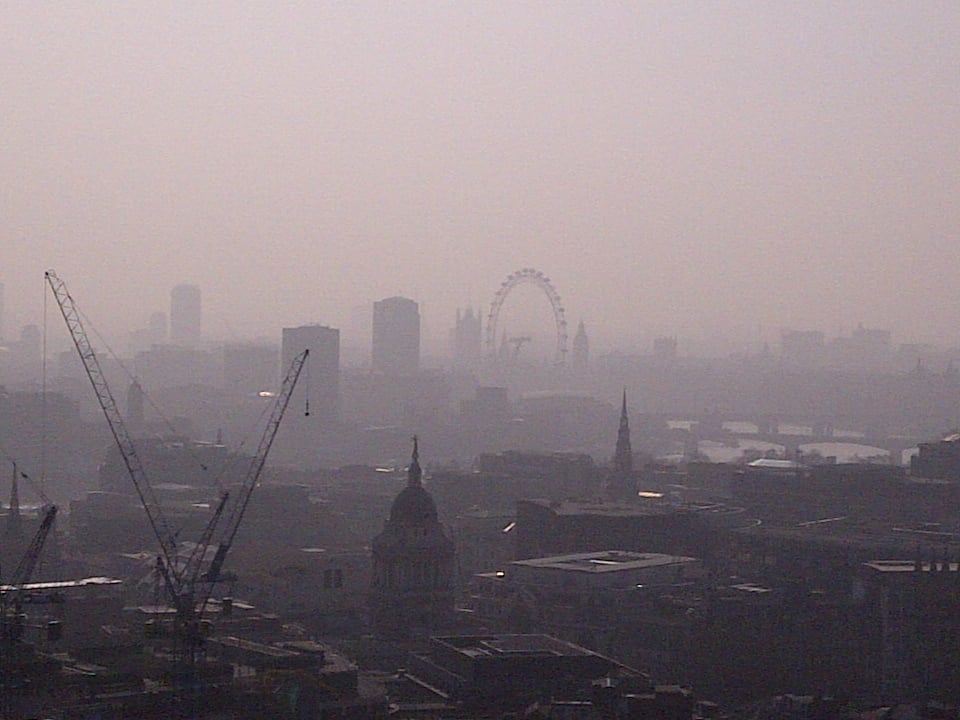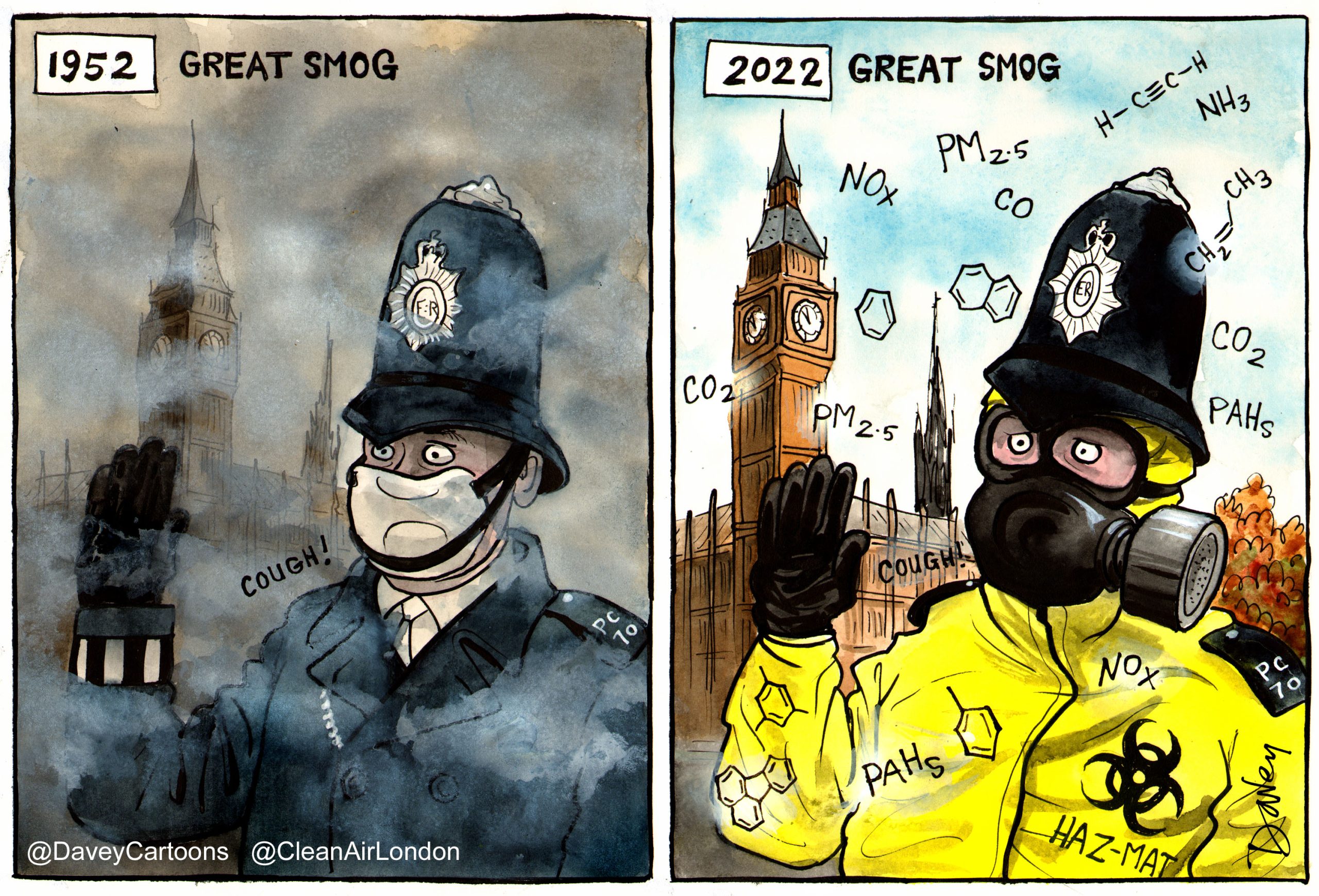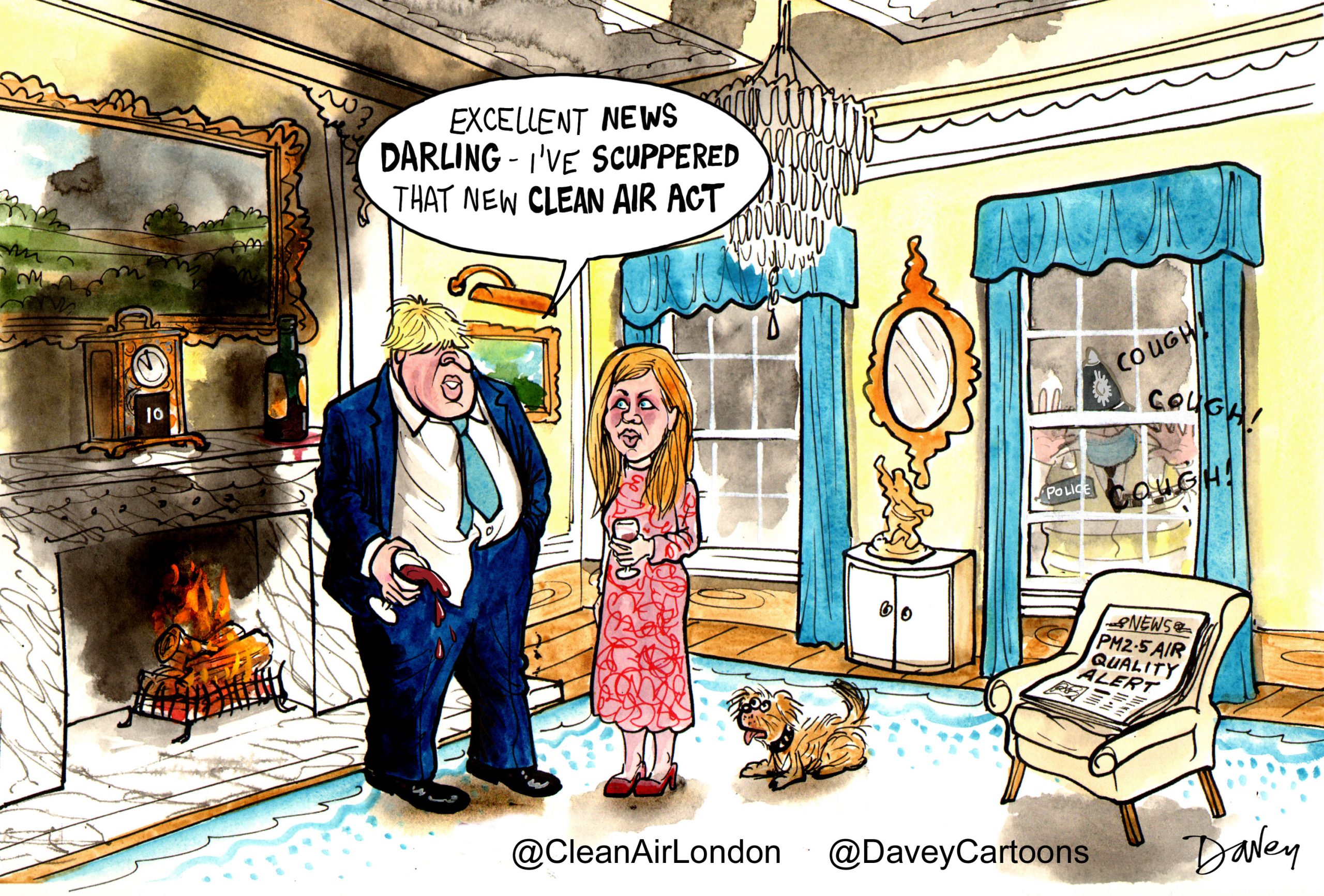Call for Evidence: Environment and Climate Change
Only the EU has competence to set Europe-wide product standards and environmental limits
75% of UK respondents to a recent Eurobarometer survey on ‘Attitudes of European towards air quality’ think that the EU should propose additional measures to address air quality problems. Only 16% of UK respondents said this is not EU competence
Free movement of goods and services requires the standardisation of products to deliver economies of scale and benefits to citizens. Contrary to Government assertions, an investigation by Clean Air in London shows failures by successive Governments have dwarfed any by European engine emission standards (which never anyway set specific limits for nitrogen dioxide (NO2))
Scientifically based health and environmental limits, backed by deadlines and enforcement, protect the public and the environment and underpin and drive innovation and efficiency. London still has the highest levels of NO2, a toxic gas, of any capital city in Europe
Free markets without product standards and environmental limits would be inefficient, increase inequalities and lead to anarchy. Rights must be matched by responsibilities
By email to: [email protected]
Dear Consultation team
Clean Air in London (CAL) welcomes the opportunity to respond to the consultation by the Department for Environment Food and Rural Affairs (Defra) and the Department of Energy and Climate Change (DECC). Details can be seen at:
https://consult.defra.gov.uk/eu/balance_of_competences/consult_view
CAL is a company limited by guarantee which campaigns to achieve urgently and sustainably full compliance with World Health Organisation guidelines for air quality throughout London and elsewhere.
CAL is independent of any government funding, has cross-party support and a large number of supporters, both individuals in London and organisations. CAL provides a channel for both public concern and expert opinion on air pollution in London and elsewhere. This document provides both general and expert comments in response to the Consultation.
Please share this response with those preparing the ‘Internal market’ and ‘Transport’ Reports and consider it also in relation to access to environmental justice, industrial and transport emissions and other matters.
Background
The review of the balance of competences is a UK Government initiative. For the purposes of this review, the Government is using a broad definition of competence saying “Put simply, competence in this context is about everything deriving from European Union (EU) law that affects what happens in the UK”.
In areas of shared competence, such as the internal market, environment and energy, either the EU or the Member States may act, but the Member States may be prevented from acting once the EU has done so.
The environment is given an important place in the EU Treaties. For example:
- Article 3(1) of the Treaty on European Union makes protecting and improving the environment a key objective of the internal market;
- Article 11 of the Treaty on the Functioning of the European Union (TFEU) states that all EU policies must take into account the needs of environmental protection; and
- Article 191(2) TFEU also sets out some significant principles which govern EU environmental policy.
Where the EU has laid down internal harmonising rules relating to environmental protection, the Member States will no longer have the competence to enter into international agreements affecting those rules. However, where the EU has only laid down minimum standards relating to environmental protection, Member States retain the power to enter into international agreements establishing other standards provided that these are not incompatible with the EU ones.
The Environment and Climate Change Report states inter alia on pages 12, 18 and 19:
- “Some argue that targets should be set as political aspirations, others that they should be based on evidence. Where adopted EU standards prove insufficient to meet existing EU targets (e.g. failure of the technical standards regulating vehicle emissions to achieve air quality limit values) this can also be controversial. But given that this is a widespread problem among EU Member States it may also be an indication of unwillingness to make the necessary societal adjustments and/or investments.” Page 12. CAL emphasis
- “[Air pollution/air quality] has to be tackled as a cross border and wider international issue. Setting health and ecosystem protection targets and emission controls for key polluting sectors at a European level therefore makes sense, as does working on wider international agreements…” Page 18. CAL emphasis
- “But the deadlines and levels of ambition for the health based limits have not always been well aligned with those for key EU source control legislation. Furthermore no provision was made to account for the possibility of significant underperformance of key EU source control legislation. The result is now widespread non-compliance across Member States with both air quality standards and emissions ceilings. The European Commission is currently undertaking a review of EU air quality policies, expected to conclude in autumn 2013.” Pages 18 and 19. CAL emphasis
In summary, existing EU law is based on fundamental principles that the right of access to the internal market – free movement of goods and service – comes with responsibilities to protect and improve the environment and public health. Further, as Defra and DECC acknowledge, air pollution has common sources and impacts across the EU.
Response
Only the EU has competence to set Europe-wide product standards and environmental limits.
The free movement of goods and services requires the standardisation of products to deliver economies of scale and benefits to citizens. Scientifically based health and environmental limits, backed by deadlines and enforcement, protect the public and the environment and underpin and drive innovation and efficiency.
Free markets without product standards and environmental limits would be inefficient, increase inequalities and lead to anarchy. Rights must be matched by responsibilities.
CAL submits the following specific evidence to the Review:
1. Health
The Environment and Climate Change Report (the Report) highlights emission reductions since 1970 (page 18) but fails to highlight that the ‘known’ health effects of air pollution have risen much faster than air pollution has reduced (or changed from visible coal smoke to invisible diesel exhaust particles). In a sense, in health terms, we are back where we ‘thought’ we were 60 years ago with air pollution [still] the biggest public health risk after smoking. Please see CAL’s guide (Exhibit 1).
Please also reference the World Health Organisation classifying diesel exhaust as carcinogenic for humans in June 2012 (Exhibit 2).
Please note that the Department of Health is wrong to suggest from the Global Burden of Disease research ranks air pollution ninth as a public health risk because inter alia:
- Table 2 in the attached Lancet article (Exhibit 3) shows that air pollution was ranked ninth only because it was excluded from the main assessment (see the second paragraph of Method and the opening paragraph of Results). The rankings also add to more than 400% by mixing ‘apples and oranges’. CAL’s guide and attachments show the Government’s own estimates (Exhibit 4) ranking air pollution, on a like for like basis, second after smoking. See also:
https://cleanair.london/health/clean-air-in-cities-index/
- The effect of air pollution is not just short-term or respiratory as in the Great Smog. The WHO’s latest REVIHAAP report on air pollution (Exhibit 5) explains, on pages 12 and 13:
‘While acute and long-term effects are partly interrelated, the long-term effects are not the sum of all short-term effects. The effects of long-term exposure are much greater than those observed for short-term exposure, suggesting that effects are not just due to exacerbations, but may be also due to progression of underlying diseases.’
- Exhibit 6 shows that the World Health Organisation’s Non-Communicable Diseases model excludes environmental exposures other than tobacco smoke.
- Please see also a benefits slide showing air pollution in the context of other public health risks (Exhibit 7).
2. Emission standards
The Environment and Climate Report explicitly and implicitly makes much of alleged failures of EU engine emission standards.
CAL submits the following evidence:
- CAL media release dated 3 April 2013 (Exhibit Eight)
- CAL report titled ‘Reducing exhaust emissions of nitrogen oxides (and particles) from diesel vehicles’ dated 3 April 2013 (Exhibit 9)
- ‘Remote sensing of NO2 exhaust emissions from road vehicles’ by Carslaw and Rhys-Tyler dated 16 July 2013 (Exhibit 10)
- Presentation titled ‘New findings from vehicle emission remote sensing in London’ (Exhibit 11)
- Presentation titled ‘Emissions and Modelling: Remapping London’s air pollution’ (Exhibit 12)
Contrary to the Government’s claims, an investigation by CAL shows failures by successive Governments have dwarfed any by European engine emission standards. Ignoring 10 years of warnings, Governments are responsible for more than doubling primary NO2 emissions from diesel vehicles – even after allowing for the increase in NO2 emissions as a percentage of NOx emissions from around 5% to over 20%.
3. London has the highest levels of nitrogen dioxide of any capital city in Europe
London has the highest levels of nitrogen dioxide (NO2) of any capital city in Europe. See CAL’s investigation dated 1 June 2013 (Exhibit 13).
4. Public confidence
A recent Eurobarometer survey on the ‘Attitude of Europeans towards air quality’ (Exhibits 14, 15 and 16) dated January 2013 found inter alia:
- 72% say that public authorities are not doing enough to promote good air quality;
- 49% of Europeans think that the challenges of air pollution can best be addressed at the European level, while 23% think these challenges are better addressed at the national level and 24% think the local level; and
- 75% of UK respondents think that the EU should propose additional measures to address air quality problems. Only 16% of UK respondents said this is not EU competence.
Please see also:
- Letter from over 60 NGOs responding to the EU consultation on the ‘Year of Air’ dated 4 March 2013 (Exhibit 17)
- Part I: Main Results from first EU consultation on the ‘Year of Air’ dated 29 May 2012 (Exhibit 18)
- Part II: Detailed results from first EU consultation on the ‘Year of Air’ dated 29 May 2012 (Exhibit 19)
- Report on second EU consultation on the ‘Year of Air’ dated 18 June 2013 (Exhibit 20)
The EU is more trusted to protect the environment and public health than the UK Government.
5. Other
CAL points the Review team to numerous reports by the European Environment Agency into need for and success of air pollution policies.
Please contact me if you wish to discuss any of this evidence.
Yours sincerely
Simon Birkett
Founder and Director
CAL 247 Exhibit 1_186 Guide to health impacts V2
CAL 247 Exhibit 2_IARC pr213_E
Exhibit 3: A comparative risk assessment of burden of disease and injury attributable to 67 risk factors and risk factor clusters in 21 regions, 1990–2010: a systematic analysis for the Global Burden of Disease Study 2010
CAL 247 Exhibit 4_238 Update App_230513_Final short version
CAL 247 Exhibit 5_221 REVIHAAP-Final-technical-report
CAL 247 Exhibit 6_238 WHO NCD draft report 311012
CAL 247 Exhibit 7_208 Presentation to Public Health Presents 271112_Benefits slide only
CAL 247 Exhibit 8_227 Update Diesel NOx and NO2_030413
CAL 247 Exhibit 9_227 Reducing NOx emissions from diesel vehicles_030413
CAl 247 Exhibit 10_Carslaw Defra remote NO2 sensing report_Final 160713
CAL 247 Exhibit 11_David_Carslaw_New_findings_from_vehicle_emission_remote
CAL 247 Exhibit 12_David_Dajnak_Emissions_and_Modelling_Remapping_London’s_Air_pollution
CAL 247 Exhibit 13_241 Update on EEA 2011 data_010613 V2
CAL 247 Exhibit 14_Eurobarometer survey fl_360_en
CAL 247 Exhibit 15_fl_360_sum_en
CAL 247 Exhibit 16_fl_360_fact_uk_en
CAL 247 Exhibit 17_231 NGO joint position paper with logos 050313
CAL 247 Exhibit 18_Survey AQD review – Part I Main results 290512
CAL 247 Exhibit 19_Survey AQD review – Part II Detailed results_290512
CAL 247 Exhibit 20_TSAP Consultation report_Second










